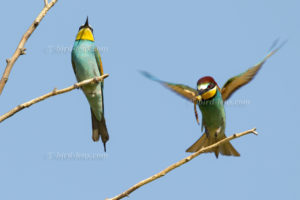 In the midday heat I am led to my hiding place. In the evening the sun is best and gives a nice backlight. It is June and the rolling hills of the Bulgarian coastal plain are covered with blooming sunflowers. A tractor is chugging in the village. Otherwise everything is quiet. I slipped into the tent and made myself invisible under the camouflage tent. Shortly afterwards, punctually as if they were waiting for me, the first : European Bee-eater (Merops apiaster) can be seen. Soon these colorful birds will be performing their acrobatics in flight a few meters in front of me. With their high, characteristic reputation, their shiny, exotic colors and their sociability, they are wonderful to observe and very beautiful photo objects. Your zest for life is downright contagious. For two years my guide has been visiting this Bee-eater colony regularly because of its special location. The birds have built their nests in the clay edge of a building material extraction and often linger on the little trees that are now growing here or on the edge itself. Perfect chances to take another bee-eater picture.
In the midday heat I am led to my hiding place. In the evening the sun is best and gives a nice backlight. It is June and the rolling hills of the Bulgarian coastal plain are covered with blooming sunflowers. A tractor is chugging in the village. Otherwise everything is quiet. I slipped into the tent and made myself invisible under the camouflage tent. Shortly afterwards, punctually as if they were waiting for me, the first : European Bee-eater (Merops apiaster) can be seen. Soon these colorful birds will be performing their acrobatics in flight a few meters in front of me. With their high, characteristic reputation, their shiny, exotic colors and their sociability, they are wonderful to observe and very beautiful photo objects. Your zest for life is downright contagious. For two years my guide has been visiting this Bee-eater colony regularly because of its special location. The birds have built their nests in the clay edge of a building material extraction and often linger on the little trees that are now growing here or on the edge itself. Perfect chances to take another bee-eater picture.
After a few static photos that were successful for my taste, however, I notice that the dynamic of the flight is the most interesting motif. So while I’m at it, I add one more thing: It should ideally be photos that capture the exact moment of take-off or landing! This requires a different approach than before. The autofocus – even that of a Canon EOS 1D X Mark III – would probably not be able to pull along here, as these birds move extremely quickly. But after a few attempts and a lot of trashed images, because either there is only a wing tip in the picture or it is completely out of focus and blurred, I succeed in the first good results. To do this, I switch to manual mode. I set the aperture to f / 8 and the shutter speed to 1 / 1,600 sec, limit the ISO number to ISO 1,600 in the auto ISO mode (in order to be able to work with longer shutter speeds) and set it to a popular start or stop Landing point sharp. With a sufficiently short shutter speed (from about 1 / 1,600 sec downwards) the vigorous flapping of the bee-eater’s wings can also be captured. In the end, you have to try out what best suits the behavior of the birds and your own ideas.
Bee-eaters are certainly one of the most sought-after objects to be photographed among the bird species found in Germany. Although there are now more settlements in the middle of Germany, for example in Saxony-Anhalt or in the Palatinate, not to mention the Kaiserstuhl, the breeding sites are rightly secret so as not to endanger the low population numbers. You don’t necessarily have to go to the Majete Game Reserve in Malawi near the Lengwe National Park on the wide, fast-flowing Shire River. Bee-eater photography is also very possible in the southern and southeastern countries of Europe. Bulgaria is predestined for this type of bird photography.
As you can see in the gallery of the bird-trip to Bulgaria, a great photo experience with beautiful nature memories and sophisticated photography. That makes it more than worthwhile to go to Bulgaria. A great country for nature lovers. It’s also a perfect destination for bird photographers.
Bird-lens is a website that aims to meet the growing demand for high-quality images, especially of birds in the Western Palearctic. In order to be able to satisfy the demand for top shots of rare bird species worldwide, Bird–Lens.com has also undertaken targeted trips to distant places such as Asia, Africa or South America. Trips to remote locations to snap pictures of rare birds of the Western Palearctic have been very successful. This beautiful picture of the blog is only a first impression, which you can find very soon in the gallery in the “Picture Shop“. Otherwise, just have a look at the gallery. Just leave a message if bird-lens.com can serve with a picture.